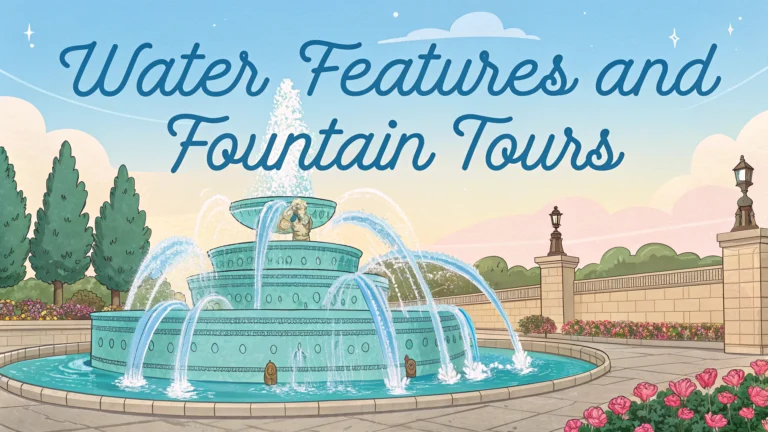Water features and fountains transform ordinary spaces into captivating destinations, making them perfect focal points for urban exploration.
This walking guide helps you discover the most remarkable water displays across cities, from historic fountains to modern water installations.
Planning Your Water Feature Walk
Download offline maps before starting your tour to ensure smooth navigation between water features.
- Best viewing times: Early morning or sunset for optimal lighting
- Equipment: Comfortable walking shoes, camera, water bottle
- Season: Spring through fall offers the best conditions
- Duration: Plan 2-3 hours for a complete circuit
Common Types of Water Features
- Classical Fountains: Traditional stone structures with tiered basins
- Interactive Fountains: Walk-through displays with programmable jets
- Wall Fountains: Vertical water features integrated into architecture
- Reflecting Pools: Still water surfaces creating mirror effects
Photography Tips
- Use slow shutter speeds (1/15 – 1/60) to capture flowing water
- Position yourself at 45-degree angles for best composition
- Include surrounding architecture for scale and context
- Visit during “golden hour” for warm, dramatic lighting
Maintenance Windows
| Season | Operating Hours | Maintenance Days |
|---|---|---|
| Summer | 7 AM – 11 PM | Mondays |
| Winter | 9 AM – 7 PM | Closed |
Safety Guidelines
- Keep a safe distance from water edges
- Don’t climb on fountain structures
- Check local regulations about water contact
- Watch for slippery surfaces around water features
Mobile Apps for Tours
- Google Maps: Create custom routes and save locations
- AllTrails: Share and follow community-created water feature tours
- PictureThis: Identify surrounding plants and landscaping
Document your discoveries by sharing photos on social media with location-specific hashtags to help other enthusiasts.
Contact local tourism offices (1-800-555-0123) for updated fountain schedules and seasonal displays.
Seasonal Highlights
Spring
- Cherry blossom reflections in pools
- New seasonal water displays unveiled
- Perfect temperature for extended walks
Summer
- Interactive fountain shows with lights
- Evening music and water performances
- Extended operating hours
Special Events
Many cities host annual water feature festivals featuring:
- Light and water choreography shows
- Historical fountain tours
- Photography competitions
- Educational workshops
Accessibility Information
- Wheelchair-accessible viewing areas marked on tour maps
- Resting benches located near major water features
- Audio descriptions available through city tourism apps
Conclusion
Water features offer unique opportunities to explore urban landscapes while providing peaceful spots for reflection and photography. Following this guide helps maximize your experience while respecting these architectural treasures.
Remember to check local event calendars for special water feature programming and seasonal celebrations. Share your experiences responsibly and help preserve these public spaces for future visitors.
FAQs
- What is the best time of day to visit water features and fountains for photographs?
Early morning or late afternoon provides the best lighting conditions, with golden hour (just before sunset) offering particularly stunning photo opportunities with less crowds and beautiful light effects on the water. - Are fountain tours typically accessible for people with mobility challenges?
Most urban water features and fountains are wheelchair accessible with paved pathways, though some historical fountains may have limited accessibility. It’s best to check specific locations in advance. - What are the most common types of fountains you’ll encounter on a walking tour?
You’ll typically see tiered fountains, wall fountains, cascade fountains, musical fountains, interactive fountains, and memorial fountains, each with distinct architectural and water flow patterns. - How long does a typical water feature walking tour take to complete?
Most self-guided fountain tours take 2-3 hours to complete at a leisurely pace, though this varies depending on the city’s size and the number of features included. - Is it acceptable to touch or wade in public fountains?
This varies by location. Some fountains are specifically designed for public interaction, while others prohibit contact. Always look for posted signs or regulations before interacting with any water feature. - What’s the best season for fountain tours?
Spring through fall are optimal, as many fountains are turned off or winterized during cold months to prevent pipe damage. Summer offers the added benefit of cooling mist on hot days. - How can I learn about the historical significance of specific fountains?
Most significant fountains have plaques or information boards nearby. Many cities also offer downloadable apps or brochures with historical information for self-guided tours. - What should I bring on a fountain walking tour?
Comfortable walking shoes, a water bottle, camera, weather-appropriate clothing, a city map or mobile device with tour directions, and cash for potential entrance fees or donations. - Are fountain tours suitable for children?
Yes, fountain tours can be very engaging for children, especially those featuring interactive water displays or musical fountains. Many fountains tell historical stories or feature fascinating sculptures that can be educational. - How can I find the best walking route between multiple water features?
Most cities provide official walking tour maps of their fountains, available through tourist offices or city websites. Digital mapping apps can also help optimize your route between features.








